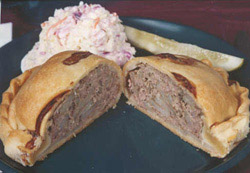

|
Upper Peninsula Pasties |
|---|
|
Introduced in the United States by Cornish miners who immigrated in the 1800's hoping to earn a good living in newly developing mines. When the Cornish came to the copper and iron mines of the Upper Peninsula, they contributed skills that were unknown to many of the other groups. Because they looked up to the Cornish miners for their skills in mining, people tended to copy other of their traditions, including the pasty. |
|
Each ethnic group contributed its own influences in the evolution of the UP pasty. A culinary rivalry developed between miners and others of different nationalities, as each asserted its own mark on the pasty in the way of seasoning and other ingredients. A descendent of Swedish immigrants to the Upper Peninsula, I was until recently under the impression that the pasty was a traditional Swedish food. |
|
The shape and construct of the pasty made it not only portable, but if it should get cold, it would be relatively easy to warm up. In the mine, this was often done by putting the pasty on a shovel and holding it over a head-lamp candle. In the workplace, as pasty wasn't eaten with a fork; it was eaten end to end, held upright to keep the juices in. |
|
The pasty survived the collapse of the mining industry because it had become popular with the major ethnic groups to remain after the mines had closed - the Finns and the Swedes. In the mid-1800's, a small wave of immigrants came from Scandinavia well after the Cornish were established. When a larger wave of Scandinavian miners came 30 years later, they were probably introduced to the pasty by the older Finns and Swedes, rather than from the Cornish. This is probably why the Upper Peninsula pasty is somewhat different from its Cornish ancestor, and why a Swede like myself may have grown up believing that the pasty was a Swedish specialty. |
|
The Upper Peninsula pasty differs from the Cornish pasty in that the vegetables are usually diced rather than sliced, there are more vegetables, and a thinner crust. |

Copyright(c) 2002,
2003, 2004 Ken Anderson. All rights reserved.
kenanderson@kenanderson.net






